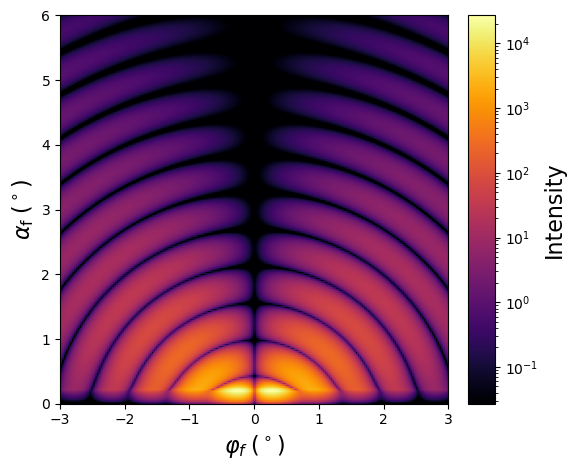1
2
3
4
5
6
7
8
9
10
11
12
13
14
15
16
17
18
19
20
21
22
23
24
25
26
27
28
29
30
31
32
33
34
35
36
37
38
39
40
41
42
43
44
45
46
47
48
49
50
51
52
53
54
55
56
57
58
59
60
61
62
63
64
|
#!/usr/bin/env python3
"""
Simulation demo: magnetic spheres in substrate
"""
import bornagain as ba
from bornagain import ba_plot as bp, deg, nm, R3
def get_sample():
"""
Returns a sample with magnetic spheres in the substrate.
"""
# Define materials
magnetic_field = R3(0, 0, 1e7)
material_Particle = ba.RefractiveMaterial("Particle", 2e-05, 4e-07,
magnetic_field)
material_Substrate = ba.RefractiveMaterial("Substrate", 7e-06, 1.8e-07)
material_Vacuum = ba.RefractiveMaterial("Vacuum", 0, 0)
# Define form factors
ff = ba.Sphere(5*nm)
# Define particles
particle = ba.Particle(material_Particle, ff)
particle_position = R3(0, 0, -10*nm)
particle.translate(particle_position)
# Define particle layouts
layout = ba.ParticleLayout()
layout.addParticle(particle, 1)
layout.setTotalParticleSurfaceDensity(0.01)
# Define layers
layer_1 = ba.Layer(material_Vacuum)
layer_2 = ba.Layer(material_Substrate)
layer_2.addLayout(layout)
# Define sample
sample = ba.MultiLayer()
sample.addLayer(layer_1)
sample.addLayer(layer_2)
return sample
def get_simulation(sample):
beam = ba.Beam(1e12, 0.1*nm, 0.5*deg)
detector = ba.SphericalDetector(bp.simargs['n'], 6*deg, 0, 3*deg)
polarizer_dir = R3(0, 0, 1)
analyzer_dir = R3(0, 0, -1)
beam.setPolarization(polarizer_dir)
detector.setAnalyzer(analyzer_dir, 1, 0.5)
return ba.ScatteringSimulation(beam, sample, detector)
if __name__ == '__main__':
bp.parse_args(sim_n=200)
sample = get_sample()
simulation = get_simulation(sample)
result = simulation.simulate()
bp.plot_simulation_result(result)
|
